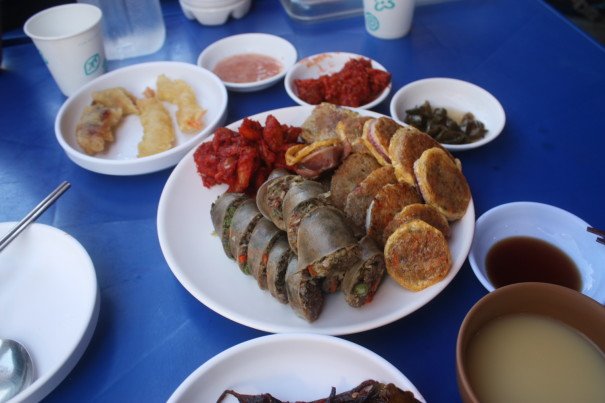
Drinking and Biking Along the DMZ

Drinking and Biking Along the DMZ
Makgeolli in Goseong
Long-distance cycling trips in South Korea have a funny way of turning into the local version of a wine-tasting tour, with grapes swapped for rice and the vintage a milky beer called makgeolli.
This time, my friend Jared and I were riding north from Sokcho, a city on the country’s east coast. “75 kilometers to Mt. Geumgang,” proclaimed a road sign on the outskirts of the city. This was optimistic, as the mountain is on the other side of the militarized border—the infamous DMZ—that has separated South Korea and North Korea for over half a century.
Soon we were passing beaches fenced off with razor wire, promontories topped with sentry boxes, and roads lined with camouflaged concrete blocks loaded with dynamite. Our goal for the day was the Unification Observatory, and we were hoping for a glimpse of North Korea’s beaches and peaks through coin-operated binoculars.
Alternating between the highway and a seaside bike path, we stopped for lunch in the town of Goseong. In the covered market, we happened upon a restaurant serving gamja ongsimi, a thick soup of potato dumplings, noodles, zucchini, and mushrooms. The proprietress easily convinced us to order a bottle of local makgeolli, then another. The brand was Seorak Raw Rice Makgeolli. Brewed with deep-sea water, it was refreshingly tart, with a hint of ocean salt.
The sentry path and bike trail began to blur during the next leg of the trip, and we passed soldiers patrolling the fence. The Korean cyclists we saw were often in groups of up to 20, all with top-of-the-line bikes. In their sunglasses and full-body uniforms, many resembled Power Rangers. The path took us through golden fields of rice, ready for harvest, and along fences strung with drying squid.
After passing the final village, Myeongpa-ri, then an abandoned shack named Last House Squid, we approached a roadblock and an arch marking the beginning of the “civilian access control line.” Three young soldiers blocked the way.
“Sorry, registered vehicles only beyond this point,” one of them said, polite but stern. We turned around, riding downhill back to Sokcho. The next day, we ended up having lunch in Abai Village, on a tiny strip of land near the harbor that was settled by refugees from North Korea.
Abai’s specialty is ojingeo sundae—squid that has been stuffed, sliced, battered and fried—and, once again, the drink of choice is makgeolli. We ordered a big bottle of Saimdang, a sweet local brew flavored with corn, and clinked bowls. The makgeolli had a yellow hue, like custard, and was a perfect match for the squid and side dishes like deep-fried shrimp.
As we sat in our plastic chairs, pleasantly fatigued and sipping on the hearty libation, it didn’t seem overly optimistic to think that we could someday continue this trip all the way up the coast to China.